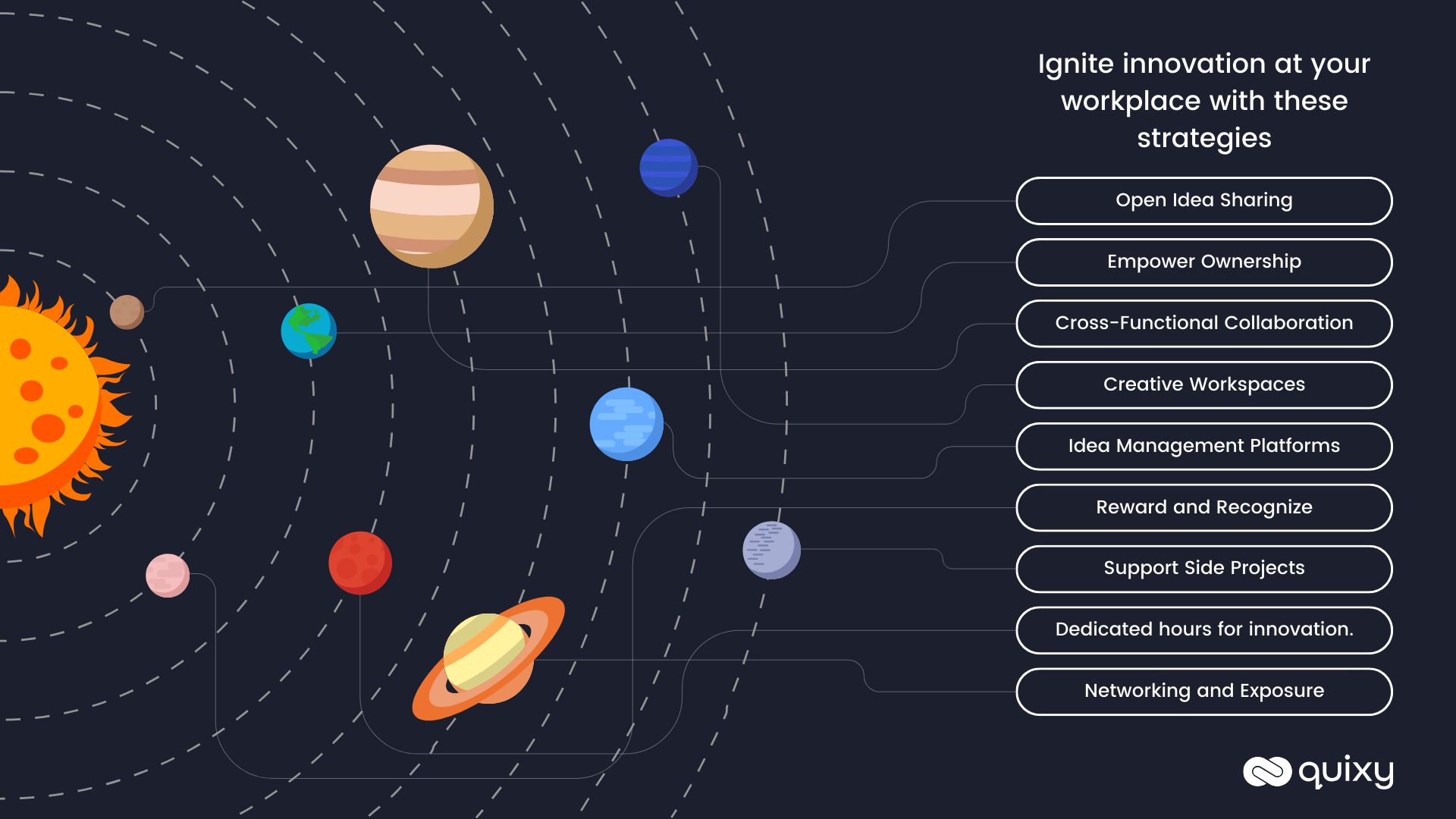
Business growth and innovation should not solely be the responsibility of a select few in leadership roles, especially in the modern business world. As a business manager, you can take inspiration from your employees. They could potentially come up with out-of-the-box innovative ideas for growth.
But first, you need to motivate them and provide them with time, resources, and platforms to work on their ideas. This will give them the push they need to step out of their comfort zone. Now, you can inspire employee innovation at your workplace in multiple ways, but you need to be aware of the challenges associated with those methods, which we will look at today.
Before we dive into nine ways to inspire employee innovation in the workplace and their challenges, let us first understand what workplace innovation means and how exactly you benefit from it.
What is workplace innovation?
Workplace innovation means developing new ideas, methods, or strategies to improve work processes, productivity, employee engagement, and overall business performance. Innovations do not always need to be major business breakthroughs or new business models. They can be a new method of doing simple tasks by leveraging the latest technology or adding a small feature to the existing product.
There is not any hard and fast rule that tells how innovation should be brought into a business. But a four-phase innovation framework, taught by Harvard Business School Dean Srikant Datar, can add structure to the innovation process.
The framework includes:
- Clarity: In this phase, the focus is on understanding the problem or opportunity clearly. It involves defining the challenge, the goals, and the scope of the innovation effort.
- Ideate: Once there’s a clear understanding of the challenge, the next step is to generate a wide range of ideas and potential solutions. This is the creative phase where you brainstorm, think outside the box, and encourage diverse perspectives.
- Develop: After the ideation phase, you narrow down the list of ideas to those with the most potential. These selected ideas are then further developed and refined.
- Implement: This phase is about turning the refined idea into reality. It involves putting the solution into action, whether it’s a new product, process, or service.
Also Read: Using No-Code for Higher Employee Engagement
What are the benefits of employee innovation?
Employee innovation is not just a buzzword. It can bring about numerous benefits for your business. Let us see some of them here:
1. Quicker problem-solving
Embracing employee innovation brings a fresh influx of diverse perspectives to the table. This diversity stimulates creative thinking and allows you to approach challenges from multiple angles, resulting in more effective problem-solving. Your employees can harness their collective intelligence to overcome obstacles and devise innovative solutions through collaboration.
2. Increased employee engagement
When employees are encouraged to contribute their innovative ideas, they feel a stronger sense of ownership and value within your business. This heightened engagement not only boosts morale but also reduces turnover rates. Employees who are empowered to make a meaningful impact are more likely to remain committed and enthusiastic about their roles.
3. Improved productivity
Innovative ideas often revamp traditional processes and workflows. By eliminating inefficiencies and outdated practices, you can significantly improve productivity at your business. Employee innovation opens doors to streamlined operations and optimized resource utilization, resulting in more efficient outputs and overall effectiveness.
4. Competitive edge
Stagnation is the enemy of progress. When you cultivate a culture of employee innovation at your business, you gain a crucial edge in today’s fiercely competitive market. By staying ahead of industry trends and responding proactively to changing customer needs, these businesses position themselves as leaders in their respective fields.
5. Use of innovative products and services
Employee innovation is not limited to employees coming up with new project ideas. It also extends to the use of new technoloy and tools in the market, such as artificial intelligence and no-code software development. Your employees might want to leverage the generative AI or no-code/low-code platforms as a solution to issues they might be facing.
6. Employee empowerment and job satisfaction
When employees’ innovative contributions are valued and implemented, they experience a sense of empowerment and fulfillment. This empowerment drives job satisfaction, as employees feel their ideas are making a genuine impact. The resulting enthusiasm creates a positive work environment that nurtures creativity and bolsters the overall business culture.
Also Read: No-Code Employee Training Management Software
What are the ways to inspire employee innovation?
Now that we know about the benefits of employee innovation let us see some ways you can inspire employee innovation at your workplace.

1. Encouraging open idea sharing through brainstorming sessions
This is one of the simplest methods to inspire employee innovation. You invite your employees to share their thoughts and ideas openly in brainstorming sessions. You can organize such sessions on a regular basis so that employees frequently get an opportunity to share their thoughts. Alternatively, you can set up a digital platform wherein the employees can submit their ideas. Having such a setup will create a collaborative environment where diverse perspectives intersect. This collaborative atmosphere will bring about unique and innovative solutions to business challenges.
Challenges associated with open idea sharing
- Idea quality and quantity: While the goal is to generate a wide range of ideas, it can sometimes be difficult to ensure both quantity and quality. Some sessions might yield numerous ideas, but they might lack depth or feasibility.
- Dominant voices: Certain individuals may dominate the discussion, overshadowing quieter voices and preventing diverse participation. This can hinder the inclusivity of the brainstorming process.
- Fear of criticism: Employees might hesitate to share unconventional or radical ideas due to a fear of criticism or ridicule. This fear can restrict the emergence of truly innovative concepts.
2. Empowering employees with autonomy and ownership of their ideas
Listening to the ideas your employees may have is one thing. Giving them the liberty to execute them in another. This autonomy to shape and execute their ideas instills a sense of ownership and accountability. This empowerment fuels their motivation to innovate and contribute to your business’s growth. At your end, you can provide employees with extra time to work on their ideas. You can address any challenges that they may be facing so that they feel supported.
Challenges associated with ownership of ideas
- Skill and knowledge gaps: Some employees might lack the necessary skills or knowledge to develop and implement their ideas fully. This can lead to frustration and suboptimal outcomes.
- Conflict of priorities: Balancing autonomy with the existing projects and priorities can be challenging. It’s important to ensure that the pursuit of innovative ideas doesn’t disrupt essential operations.
- Risk management: Granting autonomy means allowing for experimentation and calculated risk-taking. However, without proper oversight and risk management, employees might pursue ideas that are too risky or not aligned with the business’s risk tolerance.
3. Fostering cross-functional collaboration for diverse perspectives
Another step that you can take to cultivate a culture of innovation at your workplace is to foster cross-functional collaboration, wherein you encourage individuals from different departments, disciplines, and backgrounds to collaborate on projects and ideas. This approach recognizes that diverse viewpoints can lead to richer and more innovative solutions. By bringing together people with varying expertise and experiences, you can leverage the collective intelligence of their workforce to drive creative problem-solving and generate novel ideas.
Challenges associated with cross-functional collaboration
- Conflicting goals: Departments might have conflicting objectives or priorities, which can make it difficult to align efforts toward a common goal.
- Cultural differences: Different departments might have distinct organizational cultures that can clash, affecting the overall cohesion of the cross-functional team.
- Communication barriers: Different departments might have their own jargon, priorities, and communication styles, which can hinder effective information sharing and understanding.
4. Creating a physical environment that sparks creativity
The physical environment is one of the biggest motivators and inspirers. That is the reason the walls of kindergarten are always colorful. Following a similar approach at the workplace can stimulate innovative thinking and encourage employees to generate new ideas. You can design your workspaces in such a way that it fosters imagination, collaboration, and relaxation. Using vibrant colors, artwork, and natural elements for decor could be your first step. Then, you can move to installing ergonomic furniture and cozy seating options. Having areas equipped with tools like whiteboards, interactive screens, and writable surfaces also encourages spontaneous idea-sharing and visualization.
Challenges associated with the creative physical environment
- Cost: Designing and implementing a creative and innovative workspace can be expensive, especially if it involves architectural changes, new furniture, and advanced technology.
- Limited space: Some organizations might have limitations in terms of available space, making it challenging to create diverse and flexible work areas.
- Overstimulation: An environment that is too visually or audibly stimulating might lead to sensory overload, distracting employees rather than enhancing their creativity.
Also Read: 10 Ways to Promote Employee Happiness at Work
5. Implementing idea management platforms for idea sharing
In the era of artificial intelligence and machine learning, you have better options than using a diary to note down all the ideas. There are multiple idea management tools that you can utilize to facilitate the process of generating, sharing, evaluating, and implementing innovative ideas from employees across the business. These platforms provide a structured and centralized way for employees to contribute their ideas, collaborate on refining them, and track the progress of those ideas. By leveraging technology, you can streamline innovation and encourage broader participation in generating creative solutions.
Challenges associated with idea management software
- Technology adoption: Employees might face a learning curve when adapting to new digital platforms, particularly if they are not tech-savvy.
- Idea overload: The platform might become overwhelmed with ideas, making it difficult to effectively manage and evaluate each submission.
- Privacy concerns: Employees might be hesitant to share ideas on a digital platform if they are concerned about the confidentiality of their suggestions.
6. Offering rewards and incentives for innovative solutions
Rewards and recognition are another one of the biggest motivators. When the efforts of employees are recognized and rewarded, they feel valued, which only pushes them to contribute more. But, recognizing employees does not stop at praising them over an email. You should go a step further and offer tangible rewards. These could be coupons, vouchers, or even your business merchandise. Whenever your employees will look at these tangible items, they will be reminded of the reason behind them, which will give them a push to continue performing at their best capacities. Reward programs can also stimulate healthy competition among employees to come up with the best ideas and solutions.
Challenges associated with rewards and incentives
- Focus on short-term goals: Employees might prioritize ideas that have immediate rewards over more transformative, long-term ideas that may not offer quick results.
- Gamification: Overemphasis on rewards might turn the innovation process into a competitive game, leading to the submission of ideas solely for the sake of winning rewards.
- Resource constraints: Implementing reward programs can require additional resources, both in terms of finances and management.
7. Supporting innovative side projects and initiatives
Employees often feel the urge to pursue a side project along with their regular work. These side projects could be anything they are interested in. For example, a content writer interested in software development might want to step into the shoes of a citizen developer to create an application using a low-code/no-code platform. Such Citizen development projects break the monotony of their work, give them a chance to pursue their passions and bring novel ideas to the table, which benefits both the employee and the business. You can tap into your workforce’s diverse talents and creative potential by providing the resources, time, and flexibility for side projects.
Challenges associated with side projects and initiatives
- Time management: Balancing side projects with regular job responsibilities can be challenging, potentially leading to burnout or reduced performance in core tasks.
- Alignment with goals: Side projects should align with the business’s objectives to ensure that efforts contribute to overall goals.
- Resource allocation: Allocating time, budget, and other resources to side projects might strain the business’s capacity and impact other projects.
8. Allocating time for creative exploration
You can set aside dedicated time within employees’ work schedules for them to explore and experiment with creative and innovative ideas. This approach recognizes that innovation often requires time for reflection, brainstorming, and experimentation. Organizing hackathons is one of the best ways to encourage employees to not only brainstorm but execute their ideas. As a manager, you get to see the potential an idea may have, and employees also feel motivated as they have dedicated time to work on something other than their regular work.
Challenges associated with setting aside time for exploration
- Measuring ROI: Assessing the return on investment (ROI) of creative exploration projects can be difficult, especially if their impact is not immediately tangible.
- Accountability: Defining clear accountability and objectives for creative exploration projects is essential to ensure they align with business goals.
- Risk of failure: Embracing failure as part of the creative process can be difficult for some employees and might discourage experimentation.
9. Encouraging networking and exposure to new ideas
Create opportunities and a supportive environment for employees to connect with peers, industry experts, and diverse perspectives outside of their immediate teams or departments. You can set up mentorship and coaching programs and let the employees reach out to the mentors to share ideas, take feedback, or learn to navigate through challenges. Moreover, you can involve employees in industry events, conferences, or collaborations with external organizations to expose them to new trends, technologies, and innovative practices. Such exposure can stimulate innovative thinking and inspire employees to bring fresh ideas and approaches to their work.

Challenges associated with networking and exposure
- Time constraints: Employees may perceive networking and attending events as time-consuming, potentially diverting their attention from their core responsibilities.
- Unequal opportunities: Not all employees may have equal access to networking opportunities or external events, potentially leading to disparities in exposure to new ideas.
- Lack of engagement: Not all employees may be equally motivated to participate in networking or knowledge-sharing activities, potentially leading to uneven engagement.
Conclusion
Innovation is not a buzzword but a necessity to stay competitive and relevant. We have explored nine ways you can inspire employee innovation at your workplace to stay competitive and relevant. From embracing diversity to offering rewards and from creative exploration to these methods provide a rich toolkit that can help you tap into the creative potential of your workforce. However, it’s important to recognize that innovation is not a one-size-fits-all endeavor. By addressing the associated challenges and tailoring these methods to suit your unique needs and culture, you can foster an environment where innovation thrives.
Frequently Asked Questions (FAQs)
Q. Why is employee innovation crucial today?
Employee innovation is essential today as it drives adaptability and competitiveness. In a fast-paced world, organizations need fresh ideas to stay relevant. Employees’ unique insights can lead to breakthroughs, enhancing products, services, and processes. Encouraging innovation fosters a dynamic, future-ready workplace.
Q. What hinders innovation among employees?
Fear of failure, rigid hierarchies, and limited autonomy hinder innovation. Employees may hold back due to risk aversion or lack of support. Overcoming these barriers requires fostering a culture that values experimentation, encourages diverse perspectives, and provides resources for innovation.
Q. How can leaders cultivate an innovation culture?
Leaders can promote innovation by setting clear expectations, offering opportunities for experimentation, and recognizing and rewarding innovative efforts. Providing resources & creating a safe space for employees to voice ideas is essential. Leaders can lead by example to inspire a culture of continuous improvement and creativity.
Q. Why does employee engagement matter in innovation?
Employee engagement is crucial for innovation because engaged employees are more likely to invest their creativity and energy into their work. They feel a sense of ownership and commitment, leading to a higher likelihood of sharing innovative ideas and actively contributing to the organization’s success.
Q. Share examples of successful innovation in workplaces.
Companies like Google, 3M, and Apple have thrived on innovation. Google’s “20% time” policy allows employees to pursue personal projects, leading to innovations like Gmail. 3M’s culture of experimentation brought us Post-it Notes. Apple’s design-centric approach revolutionized the tech industry. These examples showcase how fostering innovation can lead to remarkable achievements.
Login
Please login to comment
0 Comments
Oldest
















